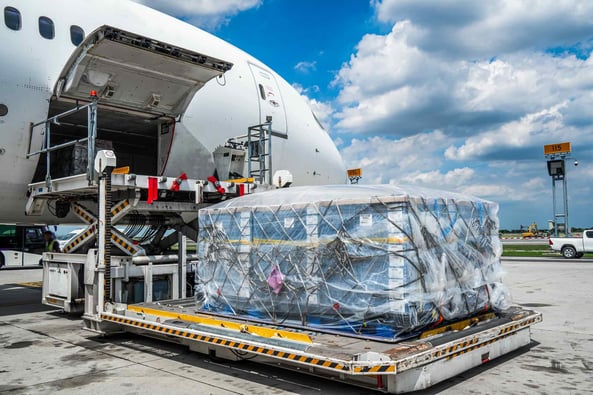
BAROMETER. Global air cargo traffic increased for the 5th consecutive month in April and freight rates are declining at a slower pace. But overall turnover is expected to fall by 13.4% in 2024.
The global air cargo industry remains well oriented, with a fifth month of double-digit growth in April 2024. As in the previous month, traffic growth is higher than capacity growth.
1/ The evolution of supply and demand
- Traffic for April 2024
According to data from the International Air Transport Association (IATA), global freight traffic stood at 21.7 billion tonne-kilometres in April 2024, representing an increase of 11.1% year-on-year, but a contraction of 6.5% month-on-month. However, in seasonally adjusted data, erosion is limited to 0.2%. "The largest contributors to this strong traffic performance in April were carriers from Asia Pacific and Europe, which together contributed two-thirds to the annual increase. This contrasts with the preceding seven months, where the bulk of the annual rise had stemmed from airlines registered in Asia Pacific and the Middle East, even though the latter is one of the smaller regions by traffic volume", says IATA.

* CTK: cargo tonne-kilometres - Data source: IATA.
Year-to-date, at the end of April, the volumes transported amounted to 85.3 billion tonne-kilometres, which represents an increase of 12.7% compared to 2023 and 1.4% compared to the value of 2022.
- Capacity
April confirmed the trend reversal observed in March: traffic growth once again exceeded capacity growth, which has a positive effect on the airlines‘ load factor. It stood at 43.9%, down 3.5 points from the previous month but up 1.6 points year-on-year. This trend benefits airlines in all regions, with the exception of African airlines for which the increase in capacity was much higher than that of traffic in April.
Overall supply growth remains dynamic: capacity increased by 7.1% compared to April 2023 and by 0.9% month-on-month (+2.3% in seasonally adjusted data), to reach 49.4 billion tonne-kilometres. This growth continues to be driven primarily by passenger aircraft belly-hold capacity, which recorded the 36th consecutive month of double-digit growth in April (+15.2% Y-o-Y). In comparison, the capacity available on all-cargo aircraft increased by only 5.0% year-on-year last month, says IATA.
2/ Price trends
While almost all routes recorded a price increase in March 2024 on a monthly basis, the observation is more nuanced in April. Freight rates have increased in the intra-Asian market and on the Asia-Europe corridor. The latter is also characterised by a year-on-year increase, the only one among the main routes in our Upply database.

Source: Upply Freight Index
This rise on the Asia-Europe corridor can be explained principally by the geopolitical situation. The Houthi attacks in the Red Sea disrupted containerised shipping, causing a spike in prices but also adding pressure on the access to capacity. Two factors that could lead shippers to turn to air cargo solutions.
In addition, transit solutions via the Middle East (including the sea-air solutions that have encountered renewed interest since the difficulties in the Red Sea) have been hampered by the severe flooding that hit Dubai Airport, which has added a little more tension to the market. The Middle East-Europe trade route also showed a notable decline of 8.5 percentage points compared to the previous month. The Middle East-Asia market also fell 9.5 points from March to reach an annual increase of 10.4% in April. This is the lowest figure in seven months. Carriers in the Middle East have suffered from these difficulties. They lost 10.6 points month-on-month, by far the largest decline among all regions. “Capacity on Middle Eastern carriers was subject to a similar reduction in April, possibly linked to geopolitical tensions between Iran and Israel as well as the heavy flooding of the Dubai International Airport,” IATA says.
Conversely, Asia-Pacific and European airlines had the highest growth rates internationally in April 2024, with 13.8% and 12.9% respectively. As for North American carriers, they still show the weakest growth, but even so there is a clear improvement.
3/ Mixed forecasts
At the beginning of 2024, airlines noticed a certain improvement of the situation, with the increase in demand exceeding that of supply, and prices rising on certain routes. However, forecasts for the year as a whole, remain mixed.
As such, after declining by 1.8% in 2023, traffic should start to rise again and show 5% growth in 2024, according to the latest IATA economic forecasts published in early June. In contrast, cargo revenue is expected to fall to $119.8 billion in 2024, down 13.4% from 2023 and 42% from the 2021 peak. The average unit revenue would reach 2.10 USD/kg. A figure still above pre-pandemic levels (USD 1.79/km in 2019) but down 17.5% compared to 2023 after having already fallen by 31.8% last year compared to 2022.
IATA is optimistic, based on some positive signals, such as the growth of the Purchasing Managers' Index (PMI) of manufacturing production or that of new export orders. However, enthusiasm was tempered by the contraction of global cross-border merchandise trade, down by 0.6% month-on-month and -0.8% year-on-year in March. “The somewhat underwhelming performance of global goods trade since the beginning of 2023 has been driven by continued inflation, impaired supply chains, geopolitical tensions, and rising cross-border trade restrictions.” So many factors that will remain present in the coming months.
Our latest articles
-
Subscriber 2 min 19/12/2025Lire l'article -
Container shipping in 2025
Lire l'article -
Air cargo: the rerouting of flows is confirmed
Lire l'article



